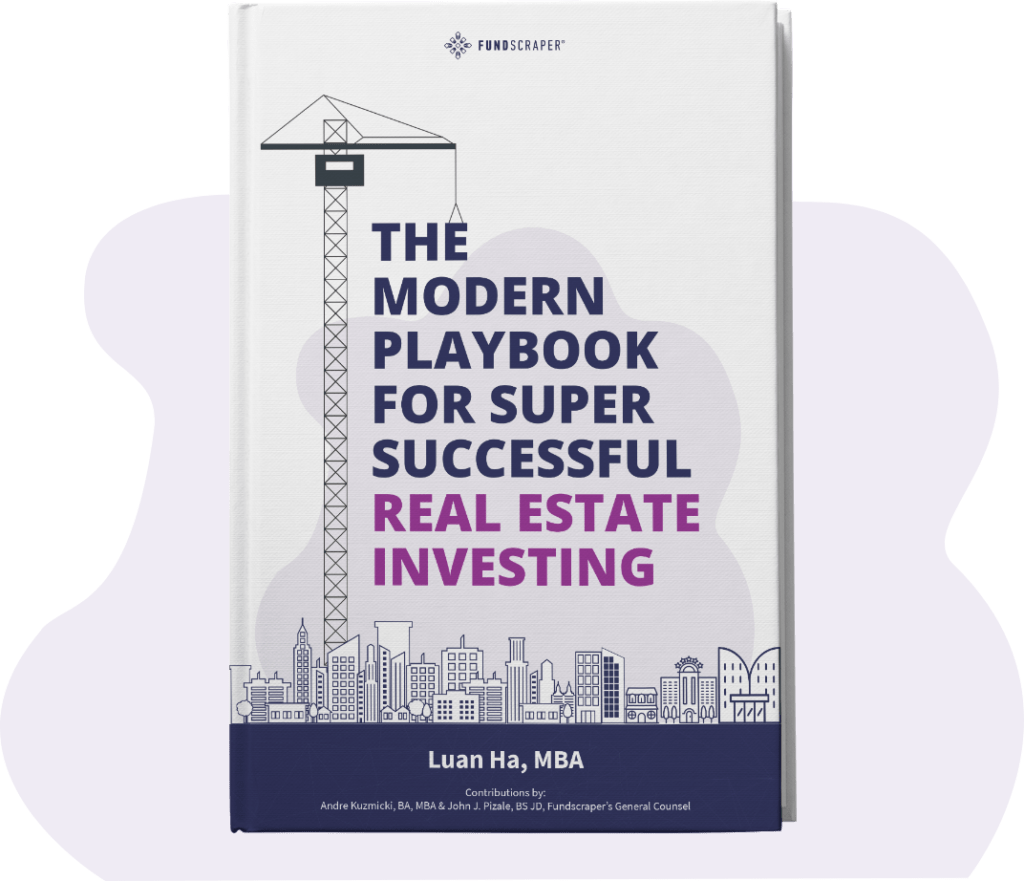In another article, I shared with you some crucial insights that I have gained from analyzing and investing in prime real estate opportunities for more than a decade. In authoring “The Modern Playbook for Super Successful Real Estate Investing,” I drew on professional football as a metaphor with its on-field success rooted in scouting, leadership, and expert play-calling. Since then, star quarterback and master play caller Tom Brady has further proven my point with a seventh Super Bowl victory. Not to be ignored is a new generation of star play callers led by Josh Allen of the Buffalo Bills and Patrick Mahomes of the Kansas City Chiefs.
Many members of Fundscraper’s investment community are interested in learning more about the thorough and comprehensive thinking behind my key “Go-To Plays.” And so, I have authored Volume 2 of the Playbook, delving into the more technical ins and outs of real estate’s big L: Location.
There’s more to assessing the location of an investment property than the literal physical location of the land. I’ll walk you through assessing the value and quality of a location based on the 5 Ls: LIQUIDITY, LEASEABILITY, LEVERAGABILITY, LENGTH OF TIME, and LOT DIMENSIONS.
The 5 + 1 L’s of Assessing Location
- Liquidity
- Leasability
- Leveragability
- Longevity
- Lot Dimensions
+ Loss – Learn to Lose a Lot or a Little
1. Liquidity
Liquidity is a measure of how fast the asset can be liquidated or converted into cash. Indirect indicators of liquidity can be measured by transaction volumes compared to other sub-markets, or by looking at comparable properties within the same asset class and how long they remained on the market before a sale (i.e. “days on market”). Understanding the liquidity of the property or location can help you assess the demand/supply dynamic of the local area sub-market and, from a defensive cash flow perspective, determine how much excess class and interest reserve should be held. In order to avoid selling an asset at an inopportune time, you need staying power. The duration of staying power you need to hold the asset is a direct function of the liquidity of the asset.
Some will say how fast you can convert into cash is a function of price, but for argument’s sake, you want to understand liquidity when the price is at fair market value.
Keep in mind, just because a location may appear to be great, it doesn’t automatically mean it’s also liquid. Illiquid locations are not a bad thing, though it depends on your time horizon and cash needs in a downside scenario. Some investors who have time use the strategy of investing in illiquid markets, hoping for the longer term growth of the asset.
Summary indicators of liquidity:
- Days on market
- Sales to listing ratio
- Absorption rate
2. Leaseability
The value of a property is in its ability to generate cash flow over the long term (an article about Discounted Cash Flow will be posted here). To determine how leasable a property is (i.e it’s “Leasability”), first consider the turnover of the typical tenants in the area (vacancy rates or occupation rates).
If you can lease it, excellent! You’re successfully extracting the largest source of return from holding real estate: the money earned from its rental income. If you cannot lease it, you’re effectively banking on the ability to sell at a higher value at some point in time in the future. And guess what? The best way to drive up the value of an asset is to maximize its income potential.
The underpinning behind this is how much capital expenditures (renovations, capital improvements) you as the investor will have to further invest in the asset to attract the appropriate tenants. This is a cost you should certainly incorporate into your projected return calculation that will likely impact the purchase price of the asset at initial acquisition.
How marketable a property is in attracting high value leases is also a function of capital spend in improving the asset. For example, having a bank as a tenant is great. But you’ll have to ensure the space can accommodate a bank vault with walls made of 3 feet of concrete. That is not a cheap build and can at times be an expensive improvement.
- NOI / CAP Rate: you can hope for cap rates to compress, but you’re best off if the asset NOI can be increased over time.
- Rent per square foot
- Net effective rent
- Occupancy rate
- Vacancy rate
3. Leveragability
Real estate is one of the most capital intensive asset classes, so assessing the ability for you to use the asset to borrow and provide adequate security or collateral is an important indicator of value (i.e it’s “Leveragability”). It is important to strike the right balance between debt and equity and in doing so to use assets for maximum advantage. The willingness of banks or other lenders to finance the property is often based on the amount of leverage and is a solid indicator of the asset’s cash flow or capacity to generate cash flow. If an asset attracts only one bank (generally the most conservative lenders) to provide financing and leverage against a property, whereas another asset has four banks lined up to provide financing, then it’s probably a good location!
Banks in general will be more comfortable in lending based on these standard metrics:
- DSCR (debt service coverage ratio): the ratio of how much cash flow the property generates relative to how much of that cash flow is spent on servicing debt.
- LTV (loan-to-value): One way to look at the LTV is assessing if there is enough cushion to return your principal in a sale event. This is a simple calculation: (Total Debt registered on the property) / (Total appraised value of the property (as-is state or at future completion)) = Equity value.
- LTC (loan-to-cost): I like looking at the LTC metric because it is an indicator of alignment with the borrower, as it is a measure of skin in the game by the borrower and is a good measure of leveragability during the development process but before completion of the asset.
4. Longevity
It’s the ultimate master play: Plan for the long term. Consider the length of time it will take to earn your return (ie. the “Longevity”) I am a proponent of long term investing, especially with land and building. Looking at the super long term returns of real estate, you’ll notice that most of your return is derived from the cash flow you are able to extract from the real estate (reference the Schulich study), i.e. rental income, as opposed to the portion of your return coming from capital gains. Remember, the emphasis is on INCOME and cash flow! So if you hypothetically held your real estate for 50–75 years, and you sold it, the return from the income every year is likely more than the return from just the gain on the appreciation of the real estate.
Looking beyond the short term will help you highlight important longer term factors that will impact the potential demand for the surrounding area. Does it require significant CapEx to maintain the duration of active use? Does the market area and community or municipal government have long term investments planned to improve the underlying infrastructure, and thus drive further economic or population growth and employment into the area?
5. Lot Dimensions
By lot dimensions, I mean the size of the land and the design and configuration of any buildings and improvements, existing or planned. For example, here’s a rough sketch of a low-mid rise building section accommodating an angular plane. Notice how the top floor steps back from the lower level floors. There are a variety of reasons why developers implement an angular plane, but it has a direct impact on potential density of the site and design.
That’s an example of needing to have sufficient depth of lot in the context of low-mid rise buildings.
High rise buildings are an entirely different topic, but according to the City of Toronto’s urban high rise design guidelines, the floor plate of the high rise tower is capped at 750 sqm. The podium however, can be much larger. How many floors is the podium? Anywhere from 4–6 floors. How much is one floor? Anywhere from 1–2 floors. How much is one floor? Depends on if it is commercial heights or residential heights. How do you measure the heights? Depends on floor to ceiling or floor to floor…
- As you can see, it gets complicated. But these details don’t really drive the overall investment decision.
- The bottom line? Pick a strategy and stick with it. But it has to be a strategy.
6. Loss – Learn to Lose a Lot or Little
Always plan for the extreme downside, don’t forget to do your due diligence.
When the odds are in a franchise quarterback’s favour, he doesn’t get comfortable or lazy; he still memorizes every play and executes every move according to plan, as practised. Even if all these variables to a good location line up, you should still cover yourself and do your diligence on other aspects of the investment.
One important thing you can do is play out the worst case scenario and ensure you can survive and carry the investment for a meaningful amount of time under those circumstances. And you definitely do not want to sell at the wrong time, so do what it takes to protect yourself and avoid the scenario of having to liquidate prematurely, including reducing your debt burden and/or bringing on capital partners. For more information, read “Ways to Diversify Your Real Estate Holdings.”
This leads us to the final principle around the 5 L’s of assessing location.You can’t always pick the winners; no recent Super Bowl champs are undefeated. You cannot expect to always win, and prices don’t just move in one direction. You must manage the downside, or risk mitigating such that you do NOT lose it all.
One of my favorite quotes from Sun Tzu, the ancient Chinese wartime political strategist philosopher and in his own right “quarterback”, is about managing the downside so you don’t collapse entirely:
Those who win well, don’t engage in wars;
Those who engage in wars well, avoid battles;
Those who avoid battles well, lose well;
Those who lose well, don’t lose it all.
The modern equivalent of this is to diversify, and to monitor your concentration.
The Bottom Line
My 5 + 1 L’s are merely general guidelines for a winning way to assess the quality of a location. There are many other variables that matter as well: proximity to transit, walk score, surrounding retail amenities, availability of good educational institutions and community facilities, probability of realizing on the financial forecasts, market mechanics, competition, regulatory changes and policy, neighborhood demographics, government investment, etc.
It’s never too late to get into the game for the first time, modernize your strategy, or score more points.
While my updated Playbook is a great tool, our team here at Fundscraper is always around to assist with coaching and help you assess opportunities best suited for you.
Fundscraper uses leading edge technology to make it easy for qualified Canadians to invest in private real estate offerings using our proprietary platform. We are breaking down the barriers where historically, only the wealthiest few were able to participate.
We continue to revolutionize how people invest in real estate and, along with our investor community and issuer clients, do it based on data-driven investment decisions. Fundscraper does the heavy lifting for you, but at the same time leaves it to you to decide which investments to choose.
Start Investing in Real Estate Backed Investments Today
Explore the investments available on Fundscraper.



